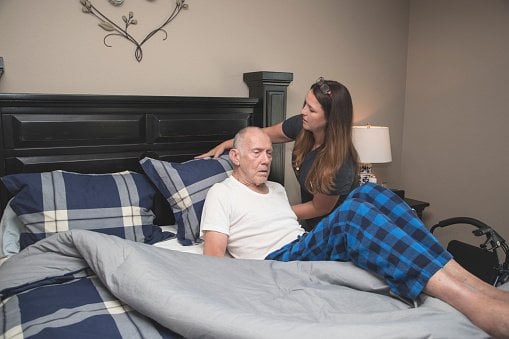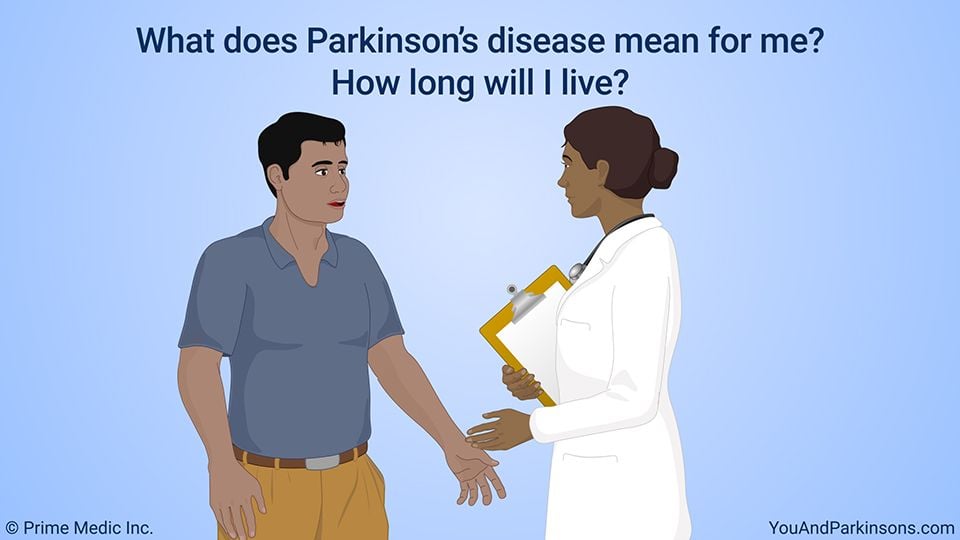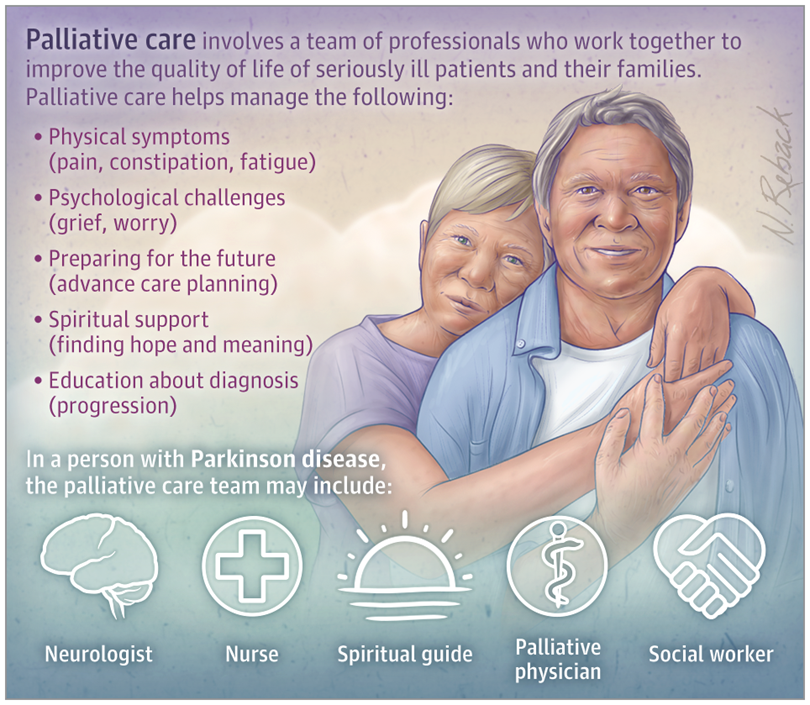Medication And Side Effects
It’s especially important that Parkinson’s medication is taken according to a fixed schedule. That way the drugs should have a stable effect throughout the day. Most people who have Parkinson’s have to take medication every day, but it’s not always easy. Various things can help if you have to take medication on a long-term basis. These include:
- regularly talking to your doctor about taking your medication,
- keeping the treatment plan simple,
- using packaging or containers that make it easier to see if a dose has been missed, and
- setting up automatic reminders, for instance on your cell phone.
Regularly taking medication is also easier if you’re well informed about what you’re taking and develop a fixed routine.
A lot of people with Parkinson’s generally have a positive attitude towards their medication. But they also find that the adverse effects can affect their quality of life. Knowing about the common side effects of the various medications can help you to decide which one to take. It also helps to correctly identify any side effects that occur. It’s important to seek medical advice if you have severe side effects. You could then change the dose or switch to a different medication. Parkinsons treatment with medication has to be regularly adjusted. It can sometimes take a while for the drugs to have the desired effect and the side effects to become tolerable.
What Are The Symptoms Of Parkinson’s Disease
The main symptoms of Parkinson’s disease are:
- tremor or shaking, often when resting or tired. It usually begins in one arm or hand
- muscle rigidity or stiffness, which can limit movement and may be painful
- slowing of movement, which may lead to periods of freezing and small shuffling steps
- stooped posture and balance problems
The symptoms of Parkinson’s disease vary from person to person as well as over time. Some people also experience:
- loss of unconscious movements, such as blinking and smiling
- difficulties with handwriting
- drop in blood pressure leading to dizziness
- difficulty swallowing
- sweating
Many of the symptoms of Parkinson’s disease could be caused by other conditions. For example, stooped posture could be caused by osteoporosis. But if you are worried by your symptoms, it is a good idea to see your doctor.
Highlights From The Canadian Chronic Disease Surveillance System
Parkinsonism, including Parkinsons disease, can have significant impacts for those affected, their caregivers, and society. With a growing and aging population, it is estimated that the number of Canadians living with parkinsonism will double between 2011 and 2031 and that the incidence will increase by 50%.Footnote 1
The Public Health Agency of Canada , in collaboration with all Canadian provinces and territories, conducts national surveillance of parkinsonism to support the planning and evaluation of related policies, programs, and services. This fact sheet presents an overview of the data on diagnosed parkinsonism, including Parkinsons disease, from the Canadian Chronic Disease Surveillance System .
Recommended Reading: Parkinson’s Bike Therapy
Try To Stay Busy And Involved In Activities
Many survey respondents said that staying busy helps them stay in good spirits. They enjoy a variety of activities, such as:
- Crafting
- Spending time with friends
- Music therapy
Do things you enjoy, try to be around friends and family who are positive, listen to music, and watch shows that make you feel happy. Plan and go on trips to places that have always interested you. When you talk to people, talk about the positive aspects of the subjects you are discussing.
Make a plan to work at eating nutritious food, doing physical exercises, and use games or other activities that help with cognitive function. Be with people who support and uplift you. Fight apathy by making a concerted effort to accomplish things that are important to you. Have gratitude for the things you are lucky to have. Remember that you have Parkinsons, but it does not have you.
Practical Tips For Better Living With Parkinsons Disease

$30.00
Did you know that you can actively impact the course of Parkinsons disease ? What you do and what you know can positively affect the quality of life for you and the person living with PD.
Join neurologist Dean Sutherland, MD, Ph.D., and occupational therapist Teepa Snow, MS, OTR/L, FAOTA, for two engaging andinformation-packed workshops.
This comprehensive Parkinsons disease toolkit will leave you informed, inspired, and ready to practice your new skills for a better life with PD.
Workshop #1 with Dr. Sutherland:
- Who gets Parkinsons disease, and how is it diagnosed?
- What are the signs and symptoms?
- Medications and treatments that can offer relief
- How exercise and support groups can help
Workshop #2 with Teepa Snow:
- After the diagnosis: What you choose to do matters!
- What helps, what hurts and what gets in the way?
- Using rhythm and movement to overcome freezing and rigidity
- Using visual and physical cues to guide and model care routines
Don’t Miss: On Off Phenomenon
Incidence Of Parkinsons Disease
Its estimated that approximately four people per 1,000 in Australia have Parkinsons disease, with the incidence increasing to one in 100 over the age of 60. In Australia, there are approximately 80,000 people living with Parkinsons disease, with one in five of these people being diagnosed before the age of 50. In Victoria, more than 2,225 people are newly diagnosed with Parkinsons every year.
The Last Year Of Life In Parkinson’s Disease
The study also examined nearly 45,000 hospitalizations in people with terminal Parkinson’s, meaning their end-of-life period.
Of those with terminal PD, the most common reasons for being in the hospital were:
- Infection
- Heart disease
- Lung disease that was not from an infection
Less common causes for hospitalization were problems related to the stomach or intestines, muscles, nervous system, or endocrine system .
It is not surprising that infection was the most common hospitalization before death, as people with Parkinson’s are vulnerable to developing a number of infections as a result of their disease. For example, bladder dysfunction in Parkinson’s increases a person’s risk of developing urinary tract infections, which can become life-threatening if not detected and treated promptly.
In addition, research suggests that aspiration pneumonia is 3.8 times more common in people with Parkinson’s as compared to the general population. It has also been consistently reported to be the main cause of death in people with Parkinson’s.
Aspiration pneumonia results from underlying swallowing difficulties, which leads to stomach contents being inhaled into the lungs. Immobilization and rigidity, which can impair phlegm removal, also contribute to the development of pneumonia in people with Parkinson’s.
Also Check: Weighted Silverware
Faith Helps And Gives People Hope
Nearly 50 percent of survey participants said their faith or spirituality is a big part of how they stay positive.
My positive attitude comes from knowing that God loves me and has me in the palm of his hand. This perspective keeps me looking ahead and lightens my spirit.
One with Parkinsons disease needs to think positively about their disease. I am a spiritual person who turns over my disease to a higher power. I stay informed about my disease. I enjoy reading about how others stay positive.
Exercise Can Positively Affect:
- Tremor
- Fine motor skills
Exercise can reduce motor symptoms such as rigidity and postural instability. Practically, exercise can make it easier to get in and out of chairs, cars or bed. It can also have a significant impact on your balance and gait.
Exercise can also reduce non-motor symptoms including sleep, constipation, depression, fatigue and cognitive function.Exercise not only reduces daytime fatigue and sleepiness, but it can also help you sleep more soundly at night. In addition, exercise releases mood-boosting endorphins and can help regulate digestion and improve constipation.
The more active I am, the better I feel. Carl Ames
Read Also: On-off Phenomenon
Changing The Mindset About Parkinsons
When asked about their quality of life, 65 percent of respondents said they have accepted their diagnosis/prognosis. They shared that having the right mindset helps them navigate their disease.
It is not the end of the world. Enjoy what you CAN do. Have a sense of humor. Laugh.
There are worse things. Seek and employ humor. Exercise.
Newly Diagnosed: Living Your Best Life With Parkinsons
A Parkinsons disease diagnosis is life-changing, but it doesnt have to keep you from living your best life. If you are newly diagnosed, you are not alone. The Parkinsons Foundation is here to assist and empower you at every stage to ensure you continue living well.
This article is based on a Parkinsons Foundation Expert Briefings webinar Newly Diagnosed: Living Your Best Life with Parkinsons” by Jenna Iseringhausen BSN, RN, Marlene and Paolo Fresco Institute for Parkinson’s and Movement Disorders, NYU Langone Medical Center, a Parkinsons Foundation Center of Excellence.
How Parkinsons is Diagnosed
There is no specific test for Parkinsons disease. Doctors look at a persons symptoms and history, and may use various tests to make a diagnosis. A person must have two of these main movement or motor symptoms to be considered for a PD diagnosis:
- Slowness of movement, known as bradykinesia
- Stiffness, or rigidity
- Tremor or shaking
Just as each person with PD is unique, so is each persons Parkinsons disease experience. Possible non-movement symptoms can include:
- Speech and memory changes
The Weight of Change
For some, a PD diagnosis is a relief an explanation for ongoing changes or symptoms. For others, it can take an emotional toll, both on the person with Parkinsons and their loved ones.
When youre ready, the Parkinsons Foundation recommends 5 steps you can take throughout your journey to support optimal living.
1. Set and Prioritize Goals
2. Talk About It
Read Also: On And Off Phenomenon
Find A Parkinsons Expert
Finding a doctor who is an expert in Parkinsons disease can help you get the best possible care. Look for a neurologist, a doctor who works with brain and central nervous system conditions such as Parkinsons. When possible, a movement disorder specialist a neurologist with additional training to treat people with Parkinsons at every stage of the disease can be a key addition to a quality care team.
Neurologists with Parkinsons expertise and movement disorder specialists can often recommend other healthcare professionals who can help treat day-to-day challenges. A holistic, team-based care approach can help you live well with PD.
What Are The Symptoms Of Parkinsons Disease

Symptoms of Parkinsons disease and the rate of decline vary widely from person to person. The most common symptoms include:
Other symptoms include:
- Speech/vocal changes: Speech may be quick, become slurred or be soft in tone. You may hesitate before speaking. The pitch of your voice may become unchanged .
- Handwriting changes: You handwriting may become smaller and more difficult to read.
- Depression and anxiety.
- Sleeping disturbances including disrupted sleep, acting out your dreams, and restless leg syndrome.
- Pain, lack of interest , fatigue, change in weight, vision changes.
- Low blood pressure.
Also Check: Zhichan Capsule
Healthy Eating And Looking After Your Teeth
Following a balanced diet will enhance vitality and help ensure that your medications are as effective as possible.
Keeping teeth and gums healthy can be more difficult if you have Parkinson’s due to the nature of its symptoms and because some of the medications used to treat it can affect dental health. There are many things you can do to improve your oral health, as well as many professionals who can offer advice.
See also Eating well and Teeth and oral health.
What Are The Five Stages Of Parkinson’s Disease
Researchers may disagree on the number of stages of Parkinsons disease . However, they all agree the disease is a progressive disease with symptoms that usually occur in one stage may overlap or occur in another stage. The stage increase in number value for all stage naming systems reflect the increasing severity of the disease. The five stages used by the Parkinsons Foundation are:
- Stage 1: mild symptoms do not interfere with daily activities and occur on one side of the body.
- Stage 2: Symptoms worsen with walking problems and both sides of the body affected.
- Stage 3: Main symptoms worsen with loss of balance and slowness of movement.
- Stage 4: Severity of symptoms require help usually person cannot live alone.
- Stage 5:Caregiver needed for all activities patient may not be able to stand or walk and may be bedridden and may also experience hallucinations and delusions.
A neurologist who specializes in movement disorders will be able to make the most accurate diagnosis. An initial assessment is made based on medical history, a neurological exam, and the symptoms present. For the medical history, it is important to know whether other family members have Parkinson’s disease, what types of medication have been or are being taken, and whether there was exposure to toxins or repeated head trauma previously. A neurological exam may include an evaluation of coordination, walking, and fine motor tasks involving the hands.
The diagnosis of Parkinson’s disease is more likely if:
Also Check: Adaptive Silverware For Parkinson’s
What Is Parkinson’s Disease
Parkinson’s disease is the second most common neurodegenerative disorder and the most common movement disorder. Characteristics of Parkinsons disease are progressive loss of muscle control, which leads to trembling of the limbs and head while at rest, stiffness, slowness, and impaired balance. As symptoms worsen, it may become difficult to walk, talk, and complete simple tasks.
The progression of Parkinson’s disease and the degree of impairment varies from person to person. Many people with Parkinson’s disease live long productive lives, whereas others become disabled much more quickly. Complications of Parkinsons such as falling-related injuries or pneumonia. However, studies of patent populations with and without Parkinsons Disease suggest the life expectancy for people with the disease is about the same as the general population.
Most people who develop Parkinson’s disease are 60 years of age or older. Since overall life expectancy is rising, the number of individuals with Parkinson’s disease will increase in the future. Adult-onset Parkinson’s disease is most common, but early-onset Parkinson’s disease , and juvenile-onset Parkinson’s disease can occur.
Top 5 Gifts To Give Someone Living With Parkinsons
Bonus Idea!
Recommended Reading: What Foods Should Be Avoided When Taking Levodopa
How Is Parkinsons Disease Treated
There is no cure for Parkinsons disease. However, medications and other treatments can help relieve some of your symptoms. Exercise can help your Parkinsons symptoms significantly. In addition, physical therapy, occupational therapy and speech-language therapy can help with walking and balance problems, eating and swallowing challenges and speech problems. Surgery is an option for some patients.
How To Design Your Life With Parkinsons
If youre like many of the people in our community, your road to diagnosis wasnt easy. It was a time of uncertainty, of going from doctor to doctor and of fear about what was to come.
Now that its real, how do you move forward?
One of the ways weve found to be helpful is to apply a design approach to your new life with Parkinsons.
When designers encounter a problem, rather than think their way forward, they build it. They build it by reframing the problem and then taking action.
Lets first look at the power of reframing the problem.
Over the past 15 years of working with people living with Parkinsons, weve seen people navigate this path in a variety of different ways. Some choose to let Parkinsons define them, while others have chosen to see it as just another bump in the road that they have to learn how to shape in a way that suits them. These people have learned how to reframe the problem.
Tina Seelig, professor at Stanford and author of Insight Out: Get Ideas Out of Your Head and Into the World, suggests three techniques for reframing a problem.
Also Check: Cleveland Clinic Parkinson’s Bicycle Study 2017
Signs Of Parkinsons Disease
In 1817, Dr. James Parkinson published An Essay on the Shaking Palsy describing non-motor, as well as, motor symptoms of the illness that bears his name. Parkinsons is not just a movement disorder, explained Dr. Shprecher. Constipation, impaired sense of smell, and dream enactment can occur years before motor symptoms of Parkinsons. The latter, caused by a condition called REM sleep behavior disorder, is a very strong risk factor for both Parkinsons and dementia . This has prompted us to join a consortium of centers studying REM sleep behavior disorder.
Parkinsons Disease Is A Progressive Disorder

Parkinsons Disease is a progressive neurodegenerative disorder that primarily affects movement and, in some cases, cognition. Individuals with PD may have a slightly shorter life span compared to healthy individuals of the same age group. According to the Michael J. Fox Foundation for Parkinsons Research, patients usually begin developing Parkinsons symptoms around age 60 and many live between 10 and 20 years after being diagnosed. However, a patients age and general health status at onset factor into the accuracy of this estimate. Age is the greatest risk factor for this condition, but young-onset Parkinsons disease, which affects people before age 50, accounts for between 10 and 20 percent of PD cases.
While there is no cure for Parkinsons disease, many patients are only mildly affected and need no treatment for several years after their initial diagnosis. However, PD is both chronic, meaning it persists over a long period of time, and progressive, meaning its symptoms grow worse over time. This progression occurs more quickly in some people than in others.
Pharmaceuticals and surgical interventions can help manage some of the symptoms, like bradykinesia , rigidity or tremor , but not much can be done to slow the overall progression of the disease. Over time, shaking, which affects most PD patients, may begin to interfere with activities of daily living and ones quality of life.
Don’t Miss: Yopd Life Expectancy